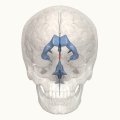Aqueduct of Silvius
Location in the brain
The Silvian Aqueduct (aquaeductus cerebri) is a canal filled with cerebrospinal fluid in the midbrain
(mesencephalon). The midbrain is part of the brainstem.

The immage below shows the ventricles as they are positioned in the head.
The red canal is the aqueduct of Silvius

Function
The Silvius Aqueduct, like a water pipe, connects the third ventricle and the fourth ventricle. Ventricles are also called cerebral cavities or ventricles.
Read more about the function and symptoms of these ventricles.
Aqueduct Stenosis
Narrowing of the Aqueduct
When there is a narrowing of the Silvian Aqueduct, it is called aqueduct stenosis.
The cerebrospinal fluid (CSF) that is produced daily (400 to 500 milliliters per day) cannot drain away.
A blockage occurs, which is called hydrocephalus.
The narrowing or stenosis can be congenital (congenital aqueduct stenosis) or caused by a tumor in the brain that compresses the aqueduct. It can also be caused by a cerebral hemorrhage, where the accumulated blood essentially blocks the tube. If no cause can be identified, it is called idiopathic aqueduct stenosis.
Diagnosis and treatment
A brain scan shows that the third and fourth ventricles (brain cavities or ventricles) are enlarged and congested.
Surgery can reduce the symptoms. A shunt (drain) is then inserted using keyhole surgery (ventriculoperitoneal shunt surgery). A shunt is a connection that allows the fluid to drain. In this case, the ventriculoperitoneal shunt (VP) drains the excess cerebrospinal fluid into the abdomen. It is also called a ventriculoperitoneal drainage (VPD).
Read more about the consequences of aqueduct stenosis:
- hydrocephalus
- cerebral edema, high intracranial pressure with headache, vomiting, and decreased consciousness
- enlarged ventricles/ventriculomegaly
Periaqueductal Gray (PAG)
Around the aqueduct is an area with many brain cells of the brainstem. This is called the periaqueductal gray (PAG) or the substantia grisea centralis.
The gray matter consists of the cell bodies of brain cells. The gray matter processes information.
The PAG has numerous connections within the central nervous system, both ascending and descending to the spinal cord.
The PAG controls, among other things, premotor brain cells in the brainstem. The brainstem then controls muscle groups such as the bladder sphincter, which helps you retain urine, and the bladder muscles, which help you urinate.
Other functions of the PAG:
- Response to pain (internal stressor) by releasing the body's own painkillers (endogenous opioids):
- serotonin
- dynorphin
- enkephalin
A distinction is made between the pain someone anticipates and the pain they actually experience. Being able to anticipate that something might hurt is very protective in everyday life because it allows one to act more cautiously.
- Reaction to a threat or defense (external stressor);
- Autonomic regulation (without volition) of blood pressure and heart rate;
- Sexual functions.
Resources
https://en.wikipedia.org/wiki/Ventricular_system
By BodyParts3D[1] by DBCLS. - Polygon data: BodyParts3D (http://lifesciencedb.jp/bp3d/).Software: Blender(https://www.blender.org/).Rendering: SheepIt (https://www.sheepit-renderfarm.com/)., CC BY-SA 2.1 jp,
https://commons.wikimedia.org/w/index.php?curid=73523944